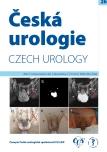A symptomatic non inflammatory paraurethral cyst in the corpus spongiosum of bulbar urethra
Authors:
Ivo Novák 1,4; Vladimír Giblo 1; Jiří Špaček 1; Petra Kašparová 2; Kateřina Hojná 3; Jiřina Svědíková 3
Authors‘ workplace:
Urologická klinika Fakultní nemocnice a LF UK Hradec Králové
1; Fingerlandův PAU, Fakultní nemocnice a LF UK Hradec Králové
2; RDG centrum, s. r. o., Rychnov nad Kněžnou
3; Urologie GIBLO – Privátní urologická ambulance, Rychnov nad Kněžnou
4
Published in:
Ces Urol 2022; 26(2): 122-129
Category:
Case reports
Overview
We present a 29-year-old man with non-inflammatory symptoms of the lower urinary tract (LUTS: testicular pain, difficulty urinating, dysuria, decrease in urine flow). As the cause of LUTS, a paraurethral cystic formation in the corpus spongiosum bulbar urethra was diagnosed by performed examinations (ultrasonographically, urethrocystoscopically, urethrographically and by computed tomography). After the primary percutaneous needle biopsy, there was a relapse, which was successfully cured by classical surgical extirpation. The patient healed uncomplicatedly after the operation. Three months after the operation, he was without subjective LUTS and in the follow-up transperineal ultrasonography, neither persistence nor recurrence of the cystic formation in the spongy body of the bulb was found. The patient‘s condition is currently stable for 3 years. The patient is permanently under the care of a urologist, there are no manifestations of infection in the urine, nor subvesical obstruction (uroflowmetry, ultrasonography of urine residues).
Keywords:
treatment – examinations – LUTS – a cyst in the corpus spongiosum bulbous urethra – Littrés gland
Sources
1. Weller CG. Paraurethral cyst within the corpus cavernosum urethrae. J. Urol. 1956; 76(1): 94–98.
2. Bujons A, Ponce de León X, Baez C, et al. Paraurethral cyst of the Littre’s gland: an exceptional case. Arch Esp Urol. 2006; 59(6): 624–626.
3. Altunrende F, White MA, Autorino R, et al. Large Symptomatic Periurethral Cystic Lesion in a Male. Urology. 2011; 78: 56-57.
4. Hakenberg OW, Froehner M, Wirth MP. Symptomatic Parauretheral Corpus Spongiosum Cyst in Male Patient. Urology. 2000; 55(4): 590.
5. Woodhouse C, Flynn J, Blandy J. Urethral diverticulum in females. Br J Urol. 1980; 52: 305–310.
6. Anderson M. The incidence of diverticula in the female. J Urol. 1967; 98: 96–98.
7. Saenz de Cabezon Mart J, Lorente Garin J, Raventos Busquets C, et al. Acquired urethral diverticulum in males with spinal cord injury. Arch Esp Urol. 1995; 48: 797–803.
8. Komada S, Yoshida K, Kondo T, et al. Congenital urethral diverticulum in a male infant: a case report. Hinyokika Kiyo. 1984; 30: 507–511.
9. Gaboardi F, Gulfi G, Bozzala A, et al. Congenital urethral diverticulum in the male: a twenty‑one year old man with a congenital urethral diverticulum at the bulbous urethra. Arch Ital Urol Nefrol Androl. 1991; 63: 347–349.
10. Sen S, Iseri C, Eryigit M. Congenital urethral diverticulum in the male. Urology. 1989; 34: 129–130.
11. Preminger G, Steinhardt G. Male urethral diverticulum: the double density sign. Urology. 1985; 26: 417–419.
12. Starzyński S, Litwak A. Cancer of the urethraoriginating from Littéś Glands. Patol Pol. 1965; 16(2): 235–41.
13. Krawitt LN, Schechterman L. Inflammation of the periurethral glands of Littre simulating tumor. J Urol. 1977; 118(4): 685.
14. Sacks SA, Waisman J, Apfelbaum HB, et al. Urethral Adenocarcinoma (Possibly Originating in the Glands of Littre). J Urol. 1975; 113(1): 50–55.
15. Kim B, Hricak H, Tanagho E. Diagnosis of urethral diverticula in women: value of MR imaging. AJR Am J Roentgenol. 1993; 161: 809–815.
Labels
Paediatric urologist Nephrology UrologyArticle was published in
Czech Urology

2022 Issue 2
Most read in this issue
- Urethral duplication in children – three cases
- A symptomatic non inflammatory paraurethral cyst in the corpus spongiosum of bulbar urethra
- Malignant solitary fibrous tumor of the scrotum
- Urolithiasis in pregnancy
